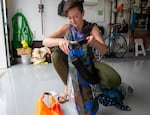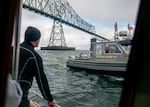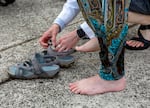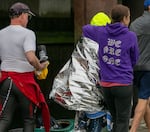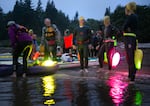
Swimmers and their safety boaters line up to begin the swim at Knappton Cove, Wash., just before dawn on Aug 11, 2024. The swim began at approximately 5:45 am to take advantage of favorable tide conditions.
Anna Lueck / OPB
The distance seemed much greater from the Washington side of the river.
Peyton Scott and her mother, Jada, carried their kayak to the shore early on the morning of Aug. 11. Scott was one of 15 people about to attempt to swim the five miles across the Columbia River from Knappton, Washington, to Astoria, Oregon.
Some swimmers traded stories of traversing the English Channel and to Alcatraz Island in San Francisco Bay. But a tension hung in the misty air, and most agreed they were nervous as they wriggled into their wetsuits.
For Scott, the nerves went deeper as she snapped on her swim cap and flippers. She’d only begun training for the Swim Across the Columbia event four months earlier. Before that, she hadn’t spent any serious time in a lap pool since she was a child. Yet, she now found herself about to wade into a body of water best known as a graveyard for incoming ships.
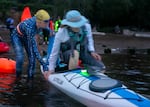
Peyton Scott stabilizes her mother Jada Scott's kayak, at the beginning of the event. Jada accompanied her daughter during the swim.
Anna Lueck / OPB
In the pitch black, she checked her supplies one last time: earplugs, a swim buoy, snacks and Coca-Cola (a favorite among endurance athletes). Her mother loaded the supplies in their kayak; every swimmer had a guide with them, and Scott’s mother would be hers.
Swimmers discussed their strategy for safely getting across: Kayakers would use compasses to navigate through the fog. Once visible, they were supposed to aim east of the iconic Astoria Column. The tides would then, hopefully, carry them south to their final destination at the Columbia River Maritime Museum.
Participants lined up to get a number written on their hands and attached bright orange buoys to their legs. In these events, it’s all too easy to become lost.
The fastest swimmers would complete the route in under three hours, but Scott wasn’t worried about her time.
Related: ‘The water’s nice today’: One man’s quest to jump in the Columbia River for 25 years
The meeting of the Columbia River and Pacific Ocean create a maze of tides that can send you hurtling in the wrong direction. It was also the first day of a salmon run, and hundreds of fishing boats patrolled the river in anticipation. When swimming in a river this dangerous, the challenge is just finishing.
“Even though I feel like I could sprint right now, my best mode is to pace,” Scott said. “I should pick my pace right now.”
Under the misty rain, the event began. The group — a collection of bright yellow swim caps against a gray canvas — trudged through the shallow end of the river before taking the plunge, their bobbing heads vanishing into the mist.

Peyton Scott in the Columbia River, attempting to complete the Swim Across the Columbia challenge, a five-mile swim from Knappton, Wash., to Astoria, Ore., Aug 11, 2024. Scott had not swum regularly since she was a child, and only began regularly training for this event a few months ago.
Anna Lueck / OPB
Scott’s swim started easily enough and her pace almost felt recreational. She talked to her mother as she swam — they marveled a nearby sea lion and laughed at the terrible flavor of pineapple protein goo.
Then, about three miles in, the mood shifted. Peyton couldn’t stop shivering and felt trapped in the middle of swirling water. She gasped and cursed as waves splashed her in the face.
A familiar doubt began to flood her mind. “Why am I doing this?” she wondered. “Is it going to be any different if I pull out now versus if I make it to the end?”
‘A crushing experience’
That question — why? — has followed Peyton Scott throughout her brief but intense journey into open water swimming.
She’d only lived in Astoria for about a year before the event; she moved to the coast to help care for her grandmother.
Scott, 32, had a penchant for trying risky new hobbies. While living in Portland in her 20s, she took up static trapeze and aerial silks, where performers use long pieces of fabric while attempting high-flying acrobatics. She had also taken up freediving, in which a person dives underwater while only holding their breath.

Peyton Scott in her home in Astoria, Ore., holding dog Chiara, Aug 11, 2024. Scott lives in a multigenerational home with her mother and grandmother.
Anna Lueck / OPB
Long-distance swimming, though, is a different beast. Scott was 5 the last time she swam competitively. Swimming in a pool, with all the ensuing safety barriers, seemed scary enough.
Still, she started practicing at her local pool almost every day, mastering basic strokes in exercises that lasted up to 40 laps, a little more than a mile. Her progress was rapid and her confidence soared. Eventually, friends suggested she join their swim across the Columbia River.
At first, she declined. A five-mile trek across the Columbia is intimidating even to seasoned swimmers. For comparison, the marathon swim at the Olympics is just over six miles.

Paul Silka, left, briefs swimmers on event logistics outside the Columbia River Maritime Museum. Silka is Emergency Department medical director for Columbia Memorial Hospital, and organized the Swim Across the Columbia event as a fundraiser for the hospital.
Anna Lueck / OPB
But Scott started to believe that maybe she could make it all the way across.
Paul Silka, the director of emergency medicine at Astoria’s Columbia Memorial Hospital who organized the swim, said Scott took to the sport right away.
“She’s got a lot of horsepower and has become very stylistic in her approach,” Silka said.
To the uninitiated, open-water swimming might seem unnecessarily dangerous, akin to base jumping or motorcycle racing. Silka compared it to mountaineering — there’s a compulsion to crossing huge bodies of water, the way others tackle Mount Everest or Kilimanjaro.
“There’s a little zen to it, because the only thing you’re thinking about is moving through that water and you’re not worrying about the everyday problems,” he said.
But for Scott, the intrusive thoughts while swimming became the most challenging aspect. As she practiced in the pool, symptoms of previous traumas began to appear: her hearing went quiet, she felt claustrophobic, and she began hyperventilating.
Related: Body of man who jumped in Columbia River to help struggling swimmer recovered
Scott had experienced physical trauma during high school, and she went untreated for years. She developed severe anxiety and an eating disorder during her college years. Even after receiving treatment, she felt she couldn’t handle stressful situations.
“I just didn’t have any coping skills to deal with the kind of mental psychological stress I was under,” she said. “I had kind of a lingering sense that I wasn’t really built to withstand things.”
This is not uncommon; studies show the stresses of exercise can also remind someone of traumatic experiences.
The thoughts started to impact her performance. In the relative safety of the pool, she would start to hyperventilate and cry as traumatic memories resurfaced. Distances she had completed with ease soon felt impossible.
“I was nervous that the water was starting to trigger me,” she said. “I had been swimming every day, and yet I would show up and I would cry.”

Peyton Scott, left, prepares for the event. Stressful experiences can trigger past trauma, and Scott had experienced anxiety, fear and doubt, during training. She feared that swimming the Columbia may be a goal outside of her reach.
Anna Lueck / OPB
Those feelings came to a head during Scott’s second practice swim in the river. Her wetsuit felt constricting, and she started panicking as everyone else outpaced her. She became conscious of her inability to keep up.
In a vast open river, the walls began to close. For Peyton, everything went silent except for her ragged gasps for air. Eventually, those in the boat pulled her out of the water.
“That felt like a crushing experience at the time,” she said. “Doubt is a huge impediment to movement.”
It seemed like a confirmation of her worst fears — maybe she didn’t have what it took and was in over her head. At some point, everything would fall apart and this experience would break her.
Now, on the day of the swim, those feelings came back at the worst possible moment.
A race against time
Scott had been in the water for nearly three hours. She couldn’t stop shivering, and she couldn’t get the words out to talk to her mother.
Jada Scott considered their options. She’d watched her daughter prepare so hard for this swim. She remembered all the times Scott came home after having to leave the pool in tears.

Peyton Scott pauses next to her mother Jada Scott's kayak to refuel and check in about navigation during the Swim Across the Columbia event in Astoria, Ore., Aug 11, 2024.
Anna Lueck / OPB
Yet, she also remembered the day Scott was pulled out of the water during that practice swim — and how she proceeded to jump back in to finish. Scott came home that day with a new perspective.
“Something inside of me, it changed,” she told her mother that day.
Other swimmers had already finished, and the picturesque Astoria skyline came into view. They seemed so close to the finish that quitting didn’t feel like an option. Jada Scott suggested that her daughter start swimming faster to increase her body temperature.
“Power with your fins,” she instructed. “The more you power with your fins, the more you’re gonna warm up.”
Scott pushed on, but the most difficult part of the swim was just starting.
The current carried them closer to the Astoria-Megler Bridge; if they ended up west of the bridge, there would be almost no place for Scott to go ashore. She no longer had time to pace herself.
“It’s just heartbreaking to see her swim more than she really needed to,” Jada Scott muttered to herself in the kayak. “I could just cry.”
Eventually, Scott came up with a plan. She told her daughter to make a beeline for a rocky embankment, where a jet ski could then take her to the museum.
“I know you can do it,” she said, “Power, power, power.”

Peyton Scott takes a moment after completing the more-than-five-mile swim across the Columbia River, Aug 11, 2024. Scott and several other swimmers were swept downstream by powerful currents.
Anna Lueck / OPB
Sprinting against the current, Scott raced to reach the shore.
Eventually, after almost four hours in the water, her hand hit land. Scott crawled up the embankment. Almost immediately, she sobbed. She cupped her face in her hands, tears blending with water, as her mother cheered only feet away.
Medics stuffed heating packs inside her sweatshirt to stop her shivering. The entire time after the swim, her jittery smile never faded, as friends and family rushed to congratulate her.
Later, she explained that this swim felt like a test: Could she complete something hard? Had she been able to all along? Was she really broken?

Wrapped in blankets, Peyton Scott, right, is welcomed on shore by her mom, Jada, left, and other friends and family. Scott was pushed downstream by strong currents and, at one point in the race, got so cold her teeth were chattering. Despite that, she says she would do the event again.
Anna Lueck / OPB
“Trauma is created when we’re sort of unable to escape a difficult experience,” she said. “That built a nagging question inside of me — since this experience harmed me, maybe I’m not resilient.
“I do think it answered that question for me. I’m definitely resilient enough.”

